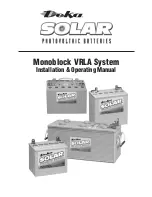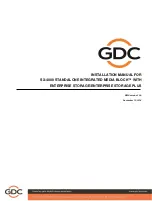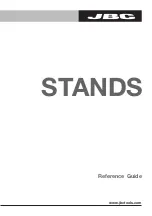
6
Charging Parameters
Charge Voltage
Bulk Charge:
Current limited to 30% of C20 or 6 times I20.
Absorption Charge:
12.10V to 14.40V per 12V battery
Float Charge:
13.44V to 13.56V per 12V battery
Equalize:
14.40V to 14.60V per 12V battery
Note: Divide values in half for 6-volt battery.
Temperature Compensation
Battery voltage should be adjusted for ambient temperature
variations.
3mV per °C (1.8°F) per cell
18mV per 12V battery
9mV per 6V battery
For temperatures above 77°F (25°C) subtract and for temper-
atures below 77°F (25°C) add.
Consult
Voltage Compensation Chart in Appendix D
for
temperature compensation voltage maximum and minimum
limits.
The average battery operating temperature should not exceed
95°F (35°C) and should never exceed 105°F (40.5°C) for more
than an eight-hour period. Operating at temperatures greater
than 77°F (25°C) will reduce the operating life of the battery.
If
operating temperatures are expected to be in excess of
95°F (35°C), contact East Penn for recommendations.
Discharging at temperatures less than 77°F (25°C) will reduce
the capacity of the battery.
Charge Current
To properly determine the amount of charge current required
the following variables are to be considered:
• DoD (Depth of Discharge)
• Temperature
• Size & efficiency of the charger
• Age and condition of battery(ies)
Maximum charge current should be limited to 30% of the C20
Ah rate for the battery(ies) being used in the system.
Example:
8G24 C20 rate – 73.6Ah
Max. recharge rate: 73.6Ah x 0.3 = 22.1A
Consult
Charging Current vs Charging Time chart in
Appendix E
as a guide line to determine recharge time from
0% to 90% state of charge at an initial charge current.
Discharge Voltage Curve
To estimate battery voltage during a constant current dis-
charge at various DoD (Depth of Discharge) consult chart
Discharge Voltage Curve in Appendix E.
NOTE: Battery voltage can vary depending on tempera-
ture, age, and condition of battery.
Grounding
When grounding the battery system, proper techniques should
be applied per electrical standards, such as NEC and/or local
codes, as well as User Manual of specific application.
BATTERY ASSEMBLY
(Always wear eye protection.)
1. Set up the batteries so that the positive post (+) of one
battery is connected to the negative post (–) of the next
battery for all series connections.
2. All battery electrical contact surfaces shall be cleaned by
rubbing gently with a non-metallic brush or pad before
installing connectors. No-Ox-ID grease can be used but is
not required.
3. Install all electrical connectors / cables and bolting
hard¬ware loosely to allow for final alignment of batteries.
Torque to manufacturer recommendations.
4. After torquing, read the voltage of the battery string to
ensure the individual batteries are connected correctly. The
total voltage should be approximately equal to the number
of batteries times the measured voltage of one battery
(when connected in series). If the measurement is less,
recheck the connections for proper voltage and polarity.
5. Read and record connection resistance and note the
method of measurement. This helps determine a satisfac-
tory initial installation and can be used as a reference
for future maintenance requirements. See Appendix B,
recording forms, in the back of the manual. Clean, remake
and re-measure any connection having a resistance meas-
urement greater than 10% of the average of all the same
type of connections.
6. Battery performance is based on the output at the battery
terminals. Therefore, the shortest electrical connections
between the battery system and the operating equipment
results in maximum total system performance.
7. Cable size selection should be determined by current
carrying requirements as well as providing a minimum
voltage drop between battery system and operation
equipment. Proper techniques should be applied per
electrical standards, such as NEC and/or local codes.
Note: Excess voltage drop will reduce the support time
of the battery system.
SYSTEM OPERATION
There are several factors that affect the operation of the battery
system concerning its ability to deliver capacity and life
expectancy. Many chemical reactions are affected by tempera-
ture, and this is true of the reaction that occurs in a storage
battery. The chemical reac¬tion of a lead-acid battery is slowed
down by a lowering of the electrolyte temperature that result in
less capacity. A battery that will deliver 100% of rated capacity
at 77° F (25°C) will only deliver 65% of rated capacity at 32°F
(0°C).
Charging
Consult Charger User Manual of specific application for
Safety and Operating requirements.
For cyclic applications it is important that the battery system
be charged fully after each discharge. It is recommended that
108% to 115% of the Ah (Amp Hour) capacity removed from
the battery system be replaced after each discharge. This addi-
tional Ah is to compensate for any efficiency losses between
the battery charger and the battery system.
Summary of Contents for SOLAR Monoblock VRLA System
Page 1: ...Monoblock VRLA System Installation Operating Manual ...
Page 12: ...10 APPENDIX B Example of typical 3 stage charger ...
Page 13: ...11 APPENDIX C Depth of Discharge vs Freezing Point ...
Page 14: ...12 APPENDIX D Capacity vs Operating Temperature ...
Page 16: ...14 APPENDIX F Charging Current vs Charging Time chart Discharge Voltage Curve ...
Page 17: ...APPENDIX G ...




































